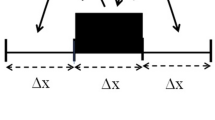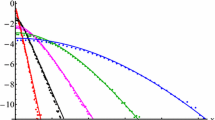Abstract
In previous papers, we presented a new theory of bi-flux diffusion processes. The bi-flux consists of the simultaneous flux of two sets of particles scattering with two distinct velocities. The first set obeys the classical Fick’s law, it is the primary flux. The complementary set follows a new law, it is the secondary flux. The primary and secondary fluxes are excited into two distinct energy states. The fundamental energy source for the primary flux is the translational energy or active energy. For the secondary flux, linear and angular momentum, both, contribute to the excitation state. Two cases are analyzed. The first one refers to an isolated system in a particular phase state S1 where active energy decreases continuously. The system tends to an energy state where active energy is absent. In the second case, the system is in a different phase state S2 where active energy increases continuously. The system recovers active energy and tends to a pure Fickian diffusion process. In both processes, the fractions representing the density distribution functions for the primary and secondary fluxes vary with time. It is remarkable that the fourth order equation provides a consistent approach to take into account the rotational energy which otherwise would not be possible with the classical theory. A particular law for the variation of the fraction of particles following Fick’s law is derived. A notion of entropy related to the particular energy states is introduced. Selected examples are presented showing the concentration profile evolution for different rates of energy transfer.










Similar content being viewed by others
References
Bevilacqua L, Galeão ACNR, Costa FP (2011) On the significance of higher order terms in diffusion processes. J Braz Soc Mech Sci Eng 34:166–175
Bevilacqua L, Galeão ACNR, Costa FP (2011) Anewanalytical formulation of retention effects on particle diffusion processes. An Acad Bras Ciênc 83(4):1443–1464
Bevilacqua L, Galeão ACNR, Simas JG, Doce APR (2013) A new theory for anomalous diffusion with a bimodal flux distribution. J Braz Soc Mech Sci Eng 35:431–440
Atsumi H (2002) Hydrogen bulk retention in graphite and kinetics of diffusion. J Nucl Mater 307–311:1466–1470
D’Angelo MV, Fontana E, Chertcoff R, Rosen M (2003) Retention phenomena in non-Newtonian fluids flow. Phys A 327:44–48
Ferreira JA, Branco JR, Silva P (2010) Non-Fickian delay reaction–diffusion equations: theoretical and numerical study. Appl Numer Math 60(5):531–549
Gruzinov I, Diamond PH, Rosenbluth MN (2003) Hysteresis and relaxation in bistable diffusive sandpile. Phys Plasmas 10(3):569–572
Rhee T, Kwon JM, Diamond PH, Xiao WW (2012) On the mechanism for edge localized mode mitigation by supersonic molecular beam injection. Phys Plasmas 19:022505
Zhukov A, Volkozub AV, de Groot PAJ (1995) Flux-diffusion-induced anomalies in the field-cooled magnetization of high-temperature superconductors. Phys Rev B 52(17):12013–12020
Yancey P, Bortnick AE, Kellner-Weibel G, dela Llera-Moya M, Phillips MC, Othblat GH (2003) Importance of different pathways of cellular cholesterol efflux. Arterioscler Thromb Vasc Biol 23:712–719
Adorni MP, Zimetti F, Billheimer JT, Wang N, Rader DJ, Phillips MC, Rothblat GH (2007) The roles of different pathways in the release of cholesterol from macrophages. J Lipid Res 48(11):2453–2462
Hancock NT, Cath TY (2009) Solute coupled diffusion in osmotically driven membrane processes. Process Environ Sci Technol 43:6769–6775
MacElroy JMD (1996) Diffusion in homogeneous media. In: Neogi P (ed) Diffusion in polymers. Marcel Dekker Inc., New York, pp 1–66
Cohen DS, Murray JM (1981) A generalized model for growthand dispersal in a population. J Math Biol 12:237–249
Riedel C, Gabizon R, Wilson CAM, Hamadan K, Konstantinos T, Marqusee SP, Bustamente C (2015) The heat released during catalytic turnover enhances the diffusion of an enzyme. Nature 517:227–230
Silva LG, Knupp DC, Bevilacqua L, Galeão ACNR, e Silva Neto AJ (2014) Inverse problem in anomalous diffusion with uncertainty propagation. In: Proceedings of 8th international conference on inverse problems in engineering: theory and practice, Cracow, Poland
Silva LG, Knupp DC, Bevilacqua L, Galeão ACNR, Simas JG, Vasconcellos JFV, e Silva Neto AJ (2013) Investigation of a new model for anomalous diffusion phenomena by means of an inverse analysis. In: Proceedings of 4th Inverse Problems, Design and Optimization Symposium (IPDO-2013), Albi, França
Acknowledgments
We are deeply indebted to our colleagues and students with whom we have discussed the fundamental ideas of this paper and who have worked out the numerical solutions of the selected problems as well. We would also express our thanks to the CNPq (National Research Foundation) for the research Grant CNPq-480865/2009-4 we were awarded and the CNPq-TWAS scholarship granted to Mr. Maosheng Jiang.
Author information
Authors and Affiliations
Corresponding author
Additional information
Technical Editor: Marcio S. Carvalho.
Appendix
Appendix
The present theory may be extended to simulate the dynamics of an arbitrary number of microstates. Clearly a real process could be better simulated by a multi-flux diffusion phenomenon since particles flow with different velocities. It is expected that, even if initially there is only one prevailing flux, after a short time the single-flux breaking effect phenomenon will raise an enormous number of microstates. That is, the model closer to the possible real case must be generalized as to include several partitions consisting of set of particles in different excitation states. Thus assuming m nested excitation states {E 1, E 2, … E m } let β i be the fraction of mass belonging to the excitation state E i . Since all the particles in the system must be in some excitation state it is necessary that \(\beta_{1} + \beta_{2} + \cdots + \beta_{n} = 1\). The governing equation for this case, assuming that the diffusion occurs in an isotropic medium, reads [3].
The fluxes are given by:
Again Ψ 1 is the primary flux while Ψ n (n > 1) are subsidiary fluxes consisting of nested states such that the state n + 1 exists if and only if the state n also exists. The coefficient D 1 is the well-known diffusion coefficient and D n (n > 1) are the reactivity coefficients. The problem now is that we lack the determination of the reactivity coefficients D n and the partitions coefficients β n besides treatable mathematical tools to perform a sufficiently detailed analysis of Eq. (7).The theory introduced in the previous sections assumes a drastic simplification reducing the system to two representative states Ψ 1 and Ψ 2 where the first correspond to the fundamental primary state and the second represents the average of the possible subsidiary states. Though this approach reducing the phenomenon to a bi-flux process, or equivalently to a dual energy excitation state represents a considerable simplification it is a second order approximation of the real phenomenon. Indeed the classical approach considers just a single class of random motion representing the scattering of particles in some supporting medium. Several works have been devoted to the diffusion process considered as the result of the Brownian motion of a very large number of particles where the relevant energy state may be associated to the kinetic energy generated by the linear momentum of all particles. The angular momentum is ignored. But as we have shown if the angular momentum plays a significant role the process than the system may be turn to be considerable complex. The system of Eqs. (7) and (8) may be considered the analytical equivalent of statistical mechanics.
Rights and permissions
About this article
Cite this article
Bevilacqua, L., Jiang, M., Silva Neto, A. et al. An evolutionary model of bi-flux diffusion processes. J Braz. Soc. Mech. Sci. Eng. 38, 1421–1432 (2016). https://doi.org/10.1007/s40430-015-0475-5
Received:
Accepted:
Published:
Issue Date:
DOI: https://doi.org/10.1007/s40430-015-0475-5




